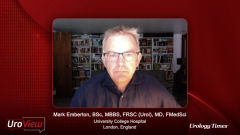
A Historical Perspective on Treatment Options for Localized Prostate Cancer
Dr Emberton provides a historical perspective of treatment options for clinically localized prostate cancer and discussed how use of these options has evolved over time.
Episodes in this series

Mark Emberton, BSc, MBBS, FRSC (Urol), MD, FMedSci: In terms of deciding how we treat prostate cancer, there's been a huge revolution in the last few years, and this relates to MRI. Before MRI, we didn't know where the cancer was. So all decisions had to be made at the whole gland level. So you either didn't treat at the whole gland level. So you left the prostate intact, that was called watchful waiting, which morphed into a more intensive form of active surveillance, versus whole gland radiation therapy versus whole gland surgery. And one doesn't have to think back very far, whether actually we were offering the same treatment to a very broad range of risk. You're offering surgery to microfocal Gleason 3 + 3, as well as Gleason 4 + 5. And so the actual risk of the disease was not changing the treatment that the individual had. MRI has changed that and has allowed us to treat or to start to think about treating at the cancer level. So in other words, not at the prostate level, i.e., we don't know where the cancer is, so we'll treat all the offending organ. MRI has now shown us that there is a cancer the size of a pea situated in the top left hand corner of the prostate, in the same that- in the same way that we use CT scan for lung cancer, mammography for breast cancer, colonoscopy for colon cancer, that allows us to direct treatment to the cancer, plus a margin. And then keep an eye on the host organ afterwards with MRI- with colonoscopy for colon, with mammography for a post-lumpectomy situation, or a CT scan following a segmental excision of a lung cancer, for instance. So prostate cancers become much more like other solid organ cancers now that we can localize the cancer. So we are in a position now to offer active surveillance for men who perhaps were overdiagnosed, who do not need treatment, whose treatment will not reduce premature death. And therefore the treatment will only confer costs and harm. We can offer, at the other end of the spectrum, whole gland treatment in a multimodality approach for very high risk locally advanced disease, and that could be surgery, radiotherapy, chemotherapy and hormones altogether. And in between, because we can identify these cancers early, we can offer individuals a selective, a spatially selective treatment to the area of the cancer, plus a margin. And thereby preserve critical functions, such as continents and erectile function and ejaculatory function which would be compromised or very likely to be compromised had the patient had whole gland treatment. So what we're seeing is a widening of the spectrum of treatment allocation based on the underlying risk, and not based on the underlying risk of historical. This is a man with a PSA of 5, with a Gleason 3 + 3. This is an underlying knowledge of risk of this individual has a five millimeter tumor, which is Gleason 3 + 4 with pattern 4 equals 10% situated in the left anterior horn of the prostate, one centimeter from the sphincter, eight millimeters from the posterior capsule of the prostate, etc. So you can see that we're getting to levels of precision that were hither to impossible to achieve which allows us to offer a very broad range of treatment, much more in line with the underlying risk of the individual that's presented to us.
Newsletter
Stay current with the latest urology news and practice-changing insights — sign up now for the essential updates every urologist needs.




















